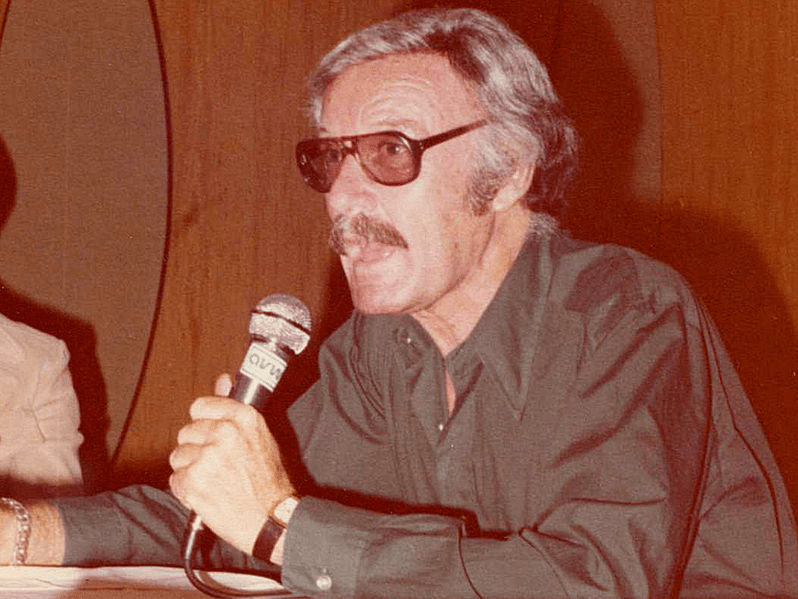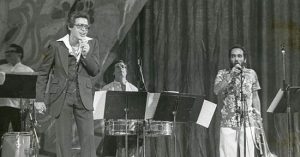Stanley Martin Lieber loved storytelling growing up, as most of his childhood was spent reading works by Sir Arthur Doyle, Mark Twain, and William Shakespeare, although he did not fully understand them. Stanley would use these books as an escape from his family’s troubles during the Great Depression. He loved storytelling and dreamed of one day writing his own great novel. Today he is better known as co-creator of many Marvel Comics characters, but he started from humble beginnings working for Timely Comics (now famously known as Marvel Comics) in 1939 as an assistant to Captain America creators Joe Simon and Jack Kirby.1
With Stanley’s new full-time job, he saw himself laying the foundation for his dream career in writing, hoping one day to be like his favorite authors and write his own great novel. Although his new job as assistant to Simon and Kirby had him running errands and doing chores, Stanley did not complain, because he was grateful to have a job during the lean days of the Depression. One day, to his surprise, Simon and Kirby threw him an assignment to create a filler story for the third issue of Captain America. The two co-creators wanted to see if he, Stanley, had any writing talent. With the publishing of the third Captain America issue, Stanley was credited with the work he did on it, but he did not use his own name; instead, he used the alias Stan Lee; and that is how most people know him today. He used this pseudonym because he actually felt embarrassed about writing comic books, which he thought were childish; moreover, he still wanted to be remembered for the great American novel he still dreamed one day to write.2

Throughout the 1940s, comic books grew in popularity, and with popularity came rising demand. Timely Comics needed to keep up with this demand if it wanted to stay in business. Timely was already a small operation at the time and with this growing demand, it needed as many writers as possible. Although Stan was young and inexperienced, Timely offered Stan Lee a chance to create his own characters. With Stan’s new position in creating characters and meeting deadlines for stories, he unfortunately had no choice but to put his life-long dream to the side. Although still being able to be a great storyteller, comic books were not how Stan saw his future. He still saw himself as a serious novelist that would one day write that “great American novel.”
In the mid-1950s, the comic book industry was under attack by psychiatrist Fredric Wertham, who claimed that violence, sex, and horror in comic books were responsible for juvenile delinquency. Juvenile delinquency was already a prominent concern in the 1950s due to other media influences, like in film, with movies like Rebel without a Cause starring James Dean, and in music, with songs of the new genre of rock’n’roll. Rock was becoming ever more popular among teenagers, with songs like “Youth Gone Wild” by Skid Row, among dozens of other songs at the time that played a hand in encouraging the youth to be daring and risky. Crimes committed by teenagers seemed to be on the rise. Wertham used this to his advantage, saying that juvenile delinquency was a problem in society due mainly to the influence of comic books. These claims by Wertham brought the establishment of the Comics Code Authority, which policed comic books for objectionable material. As a result, sales of comics dropped. Comic books were so popular because, although fictional, they would touch on real life issues. The result of Wertham’s efforts was that the comic book industry was brought to its knees with the establishment of the Comics Code Authority. With the comic book industry in a dire situation, Martin Goodman (C.E.O. of Timely) had Stan lay off a majority of the staff at Timely Comics so that Goodman’s company could financially stay alive. Over time, Stan grew tired of writing comic books, and even considered quitting his job. Between the backlash comics were receiving, and having to lay off the majority of his co-workers/close friends, Stan felt hated and guilty. Moreover, Goodman continuously pressured Stan to write stories for characters he had little to no interest in, which also made him feel trapped and unhappy.3

Stan’s career in comics had become an anchor around his neck, and his dream of ever becoming a novelist felt like a distant mirage that he would never be able to reach. In the late 1950s, Stan brought his conflict to his wife Joan. Joan suggested that he think of a comic book story that he wanted to tell with characters he wanted to create and publish. She told Stan, “the worst Goodman can do is fire you, and you’re thinking about quitting anyways.”4 Joan sparked one last bit of hope in Stan that would motivate him to create something never seen before in comics. Sometime before bringing his dilemma to Joan, Goodman had come to Stan and ordered him to create a superhero team that could rival DC Comics’ Justice League of America in popularity. Stan saw this as his last chance to make something of himself in the comic book world. With Goodman’s demand and Joan’s advice, Stan created one of the most iconic superhero teams ever: The First Family of Marvel: The Fantastic Four. Although he never ended up writing his great American novel, Stan found an outlet for his creativity with the successful launch of The Fantastic Four. Stan created a group of superheros that battled villainy as much as domestic issues at home, because they were heroes that were a family: brother and sister, Johnny and Sue Storm aka The Human Torch and The Invisible Woman. Sue was married to Reed Richards aka Mr. Fantastic, and Ben Grimm aka The Thing, Reed’s best friend, who was essentially a big brother figure to hot head Johnny Storm. Stan created the Fantastic Four to stand out, he created them to be a family with a twist, Reed was the Father of the family/leader of the group, and Sue was his wife. Johnny was created to appeal to the younger audience as he was the young kid brother. Ben was the twist in the family. Besides having powers, Ben was made to be a gentle giant and lovable monster that would be a close friend of the family. Ben and Johnny would often prank each other while on a mission or inside The Baxter Building (home base of The Fantastic Four). Ben was also created to be connected to Reed as a sense of guilt for Reed. Reed was responsible for the experiment that gave the team superpowers, and Ben was disfigured as a result. Reed would always carry the guilt of Ben’s disfigurement even though Ben had come to terms with his new look.5

The creation of The Fantastic Four was the turning point for Stan Lee and Timely Comics, (now officially Marvel Comics). Stan received mail from fans demanding more from The Fantastic Four and for Stan to create costumes for the characters, because in their first appearance, Stan created them without superhero costumes. The First Family of Marvel changed everything. They set the foundation to how superheroes would be created in The Marvel Universe. Audiences were able to empathize with their favorite characters like never before in the comic book world. The connection between characters and audiences skyrocketed Stan’s and Marvel’s future and prominence in the comic book world, and both Stan and Marvel became icons.
Unfortunately, Stan Lee passed away at the age of ninety-five on November 12, 2018, due to congestive heart failure. Many people mourned on that day because Stan Lee was loved by his fans; his material touched audiences all over the world. Stan Lee built his legacy from the ground up. He started as assistant to Joe Simon and Jack Kirby, became editor and chief, and then creator to some of the most memorable characters of The Marvel Universe that we know and love today. Stan Lee will be missed by many. He is gone but never forgotten, Excelsior!!! To The King of Comic Books.
- St. James Encyclopedia of Popular Culture, 2013, s.v. “Marvel Comics.” Bradford W. Wright, 473-475. ↵
- Bob Bachelor, Stan Lee: The Man Behind Marvel (Maryland: Roman & Littlefield publishers, September 5, 2017), 33-38. ↵
- Contemporary Authors, New Revision Series, 2004, s.v. “Lee, Stan 1922-“, 244-246. ↵
- Anthony Breznican, “Stan Lee: A Life of Marvel,” Entertainment Weekly, November 30, 2018, 24-26. ↵
- Anthony Breznican, “Stan Lee: A Life of Marvel,” Entertainment Weekly, November 30, 2018, 8-9. ↵



56 comments
Kelsey Sanchez
I loved and enjoyed reading this article! I really enjoyed all the comic books he had created and how he was able to turn his passion into something already he was working in. I am glad Stan Lee left us with Marvel superheroes and good stories that are inspiring. I feel that if he was still alive he would come up with other great and amazing comics that would later be known as award-winning movies. It was so sad to hear the day he passed away, but I know his legacy will always be remembered and will go on forever in the memory of him.
Raul Vallejo
This Article was a great read and really told me more about the man who pretty much has shaped the modern box office. I have always been a fan of the marvel movies and feel a sense of endearment toward Stan Lee because of how much I appreciate the work and dedication that he has done.
Thalia Romo
This article is great because I learned more information about Stan Lee that I had not previously known. I didn’t know that he had taken inspiration from Shakespeare, Mark Twain, and Sir Arthur Doyle, to become a professional writer. It’s interesting to think that Lee was an assistant to the creators of Captain America, which is most likely where he took some of his later inspiration from. I think it was smart of Stan Lee to be humble and keep his job, especially during the Great Depression, however, due to him experimenting, going outside of his comfort zone and taking a chance, he was able to change the comic industry forever.
Vanessa Quetzeri
I have watched a couple of Marvel movies; my family loves them. I have never heard of The Fantastic Four or Timely Comics, but it is interesting to learn that it was what launched Stanley Lieber’s career and future creation of the Marvel Comics. He influenced the many Marvel Movies based on his comics, which I find admirable and even got to cameo in most of them.
Charli Delmonico
This was a fantastic article. I haven’t seen all the Marvel movies, and I most definitely didn’t watch them in order, so I had no idea that The Fantastic Four was what kicked off all the Marvel comics. That one was always one of my favorites, and I’m so glad that Stan Lee stuck with his comic writing since he became one of the most famous writers in modern day America.
Nicole Ortiz
Stan Lee was such a remarkable and well-known man by many. So many people cared about him because many of us grew up reading the comics he created as well as watching the movie interpretations of them. It was such a sad day when Stan Lee died and i will forever miss his cameos in each one of his Marvel movies.
Briley Perkins
I love Marvel so much! The contribution of Stan Lee to the world is really great that changed the public’s view of superheros as well as his own life. I would say that Joan’s words had a great influence in the creation of marvel. have never heard about how he started out as just an assistant writer in Marvel. This was a great article and it was very informative and well written.
Bruno Lezama
If you see Marvel movies, you have to know who is Stan Lee because e there is always a scene in each of the movies where he acts as an extra. I know him because of the movies more than for the comics that he wrote. I can’t imagine what Stan Lee felt when he saw his comics in a movie. This article tells the story of Stan Lee very well. For example, I didn’t know that Stan Lee is not his real name. Interesting article!
James Disrud
I always knew Stan Lee from all the iconic comic book characters he created and the countless cameos he did in the marvel movies. Before reading this I new very little about Stan Lees backstory and this article gave me some good info. Stan Lee changed a countless number of peoples lives through his visions. This was a well written article that I enjoyed reading it gave me a better insight into the backstory of Stan Lee.
Elizabeth Maguire
This article was an enjoyable read. I have always like watching the Marvel movies and I truly appreciate the creations of Stan Lee. I had known that comic books were an escape from reality because the Great Depression was a tough time for everyone. This article was very enlightening.